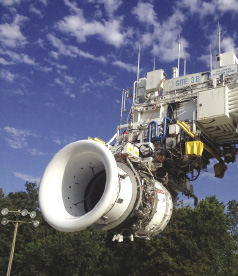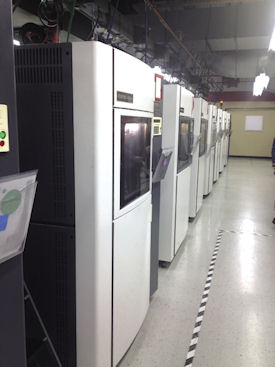Additive Manufacturing’s New Design Paradigm
3D printing allows companies to rethink previously impossible to manufacture designs, optimize their products, and support new business models.
Latest News
December 1, 2013
 CFM International, a joint venture between Snecma (Safran) and GE, initiated testing of the first full LEAP engine in September. The engine includes 19 3D printed fuel nozzles. |
In September, a small part that will make a big splash in the world of manufacturing was successfully tested. It’s a new fuel nozzle being developed by GE Aviation for the next-generation LEAP jet engines, which are scheduled to be in production by 2015. GE says the fuel nozzle is 25% lighter and as much as five times more durable than the current nozzle. It is being 3D printed in one piece, as opposed to the 20 parts that comprise the current model. Those numbers are impressive, and illustrate the weight and process optimization benefits of additive manufacturing (AM), but they are not the most remarkable part of GE’s announcement.
The number that has everyone taking notice is 85,500. That’s how many of the new 3D printed fuel nozzles GE Aviation will produce in order to install 19 of the parts in the 4,500 LEAP jet engines that have already been ordered.
GE calls itself the largest user of additive technologies for metallic parts, and it has one of the largest fleets of 3D printers that it regularly uses for prototyping and tooling. While it’s no longer unusual to use 3D printing to simplify the production of complicated parts, or to optimize specialized parts for weight and strength, the volume of fuel nozzles GE plans to make via its direct laser melting process is unprecedented. In fact, it’s so far forward that it’s not feasible yet.
GE’s Business Development Leader for Additive Manufacturing, Greg Morris, recently told Bloomberg.com that existing additive manufacturing (AM) systems aren’t efficient enough to economically meet the demand, so GE is banking on the development of new, more efficient 3D printers. Morris should know the existing technologies’ limitations. GE Aviation acquired the 3D printing company he founded, Morris Technologies, and its sister company, Rapid Quality Manufacturing, in November 2012.
“Throughput is an issue,” admits Prabhjot Singh, manager, Additive Manufacturing Lab, GE Global Research. The $27 million lab acts as a central research and development hub focused on developing new AM processes for all of GE. “We’re not talking one-offs, we’re talking hundreds of thousands of parts.”
Consistent Quality
However, Singh seems more concerned with quality. “Making sure every part is made consistently is a top concern moving forward,” he says. “More and more parts are going to pass though additive manufacturing machines, and they all will need to be qualified. That’s a big challenge.”
The infrastructure needed to produce parts in high volume: materials for specific applications, a published materials database of characteristics, rapid part inspection systems, better post processing, better design tools, and a supply chain for all of the above, isn’t yet mature.
“We have a very strong materials and manufacturing group,” Singh says. “It is helping us bring in new technology and mature it to our needs. The engineering teams we work with keep us real, and they help us develop the right kinds of technology.”
 RedEye on Demand by Stratasys is a “factory of the future” that quietly creates parts using 150 AM systems. |
In a recent webcast titled “The Future of Manufacturing,” GE Global Research’s Technical Director, Manufacturing & Materials Technologies, Christine Furstoss, echoed Singh’s concerns.
“We’re just learning what gives the materials the types of properties it’s achieving,” she said. “What are the things we can do in the equipment to make sure we make a material strong enough and tough enough? How do we make sure we do that every time for every part?”
While GE has been able to develop that quality control process for its new fuel nozzles, it needs to grow exponentially to advance other end uses for AM technology.
Expanding the Reach of Additive Manufacturing
Thus far, professional 3D printing technology has largely focused on rapid prototyping and what Stratasys’ CEO David Reis calls augmented manufacturing, which refers to using 3D printers to create tools, jigs and templates to support traditional manufacturing processing. The design cycle optimization opportunities for prototyping are obvious: a physical model can be used to advance a concept, sell executives on a design change, or cut down on costlier physical testing.
| MakerBot Academy LaunchedThe US has been the leader in additive manufacturing (AM) ever since 3D Systems’ founder Chuck Hull patented stereolithography and Scott Crump designed Stratasys’ first 3D printer, but that may be changing. Both the UK and China have invested serious amounts of money into the technology, and the EU, with the European Space Agency as a partner, isn’t far behind. The US does have its own investments in place, such as America Makes, the National Additive Manufacturing Innovation Institute, but the race is tight. MakerBot is hoping to help keep the US at the forefront of AM with its MakerBot Academy program. It represents a partnership between donorschoose.org, Autodesk, America Makes, and, of course, MakerBot (now a owned by Stratasys). Businesses and individuals who would like to assist with the MakerBot Academy program can visit donorschoose.org and offer financial support for the program. Teachers can then register on the site to receive a MakerBot Academy bundle. Each MakerBot Academy bundle includes a MakerBot Replicator 2, three spools of PLA filament, and a full year of the MakerBot MakerCare Service and Protection Plan. MakerBot will also assist teachers in the development of ongoing 3D printing curriculum for classroom activities, and draw upon Autodesk’s software and educator curriculum as well. —John Newman |
“People are less aware of the augmented part of additive manufacturing,” Reis says. “It’s a huge opportunity for Stratasys and a huge opportunity for our customers. All of them are using tools today in a traditional way, which is long, expensive, not efficient. Here (with 3D printing) we have tools that can go into production the next morning. There are hundreds of thousands of production facilities who can use this technology today.”
While augmented manufacturing brings design engineers one step closer to the manufacturing process, creating end-use parts via 3D printers the way GE is doing—what Reis calls alternative manufacturing—further breaks down the walls between design and build. With business units in power and water, oil and gas, energy management, aviation, health care, transportation, and home appliances that dwarf many competitors in their own right, GE is in the rare position of being able to advance alternative manufacturing in many industries. The way it does so will no doubt serve as a template for other companies looking to use 3D printing to speed design and development.
During the GE webcast, Furstoss called AM part of the next industrial revolution that “represents a convergence of design and materials and manufacturing. It’s a new way of thinking about manufacturing as being as important as any product. That process is the product. That materials and manufacturing and design can meet.”
Such a meeting could shift the design engineer from the front of the design-to-manufacture process to its center. If the process is the product, then the engineer will be designing for manufacture in a way that makes an immediate impact on a company’s output. In some instances, the time to market would be measured in hours, not days, weeks or months.
An example of this was presented at Stratasys’ Manufacturing the Future Summit in October by Bryan Dods, an executive in Manufacturing Engineering & Technology at GE Power & Water. Dods’ customers include large power plants that could stand to lose $1 million each day that they’re offline due to a faulty part. If a 3D printed part could be designed and manufactured to get them up and running quickly, it would change the traditional design to manufacture cycle for that service industry.
Challenges are Opportunities
GE’s investment in AM bodes well for advancing the technology, but there’s still a long way to go. Despite the challenges of new materials and quality controls, there seem to be nearly endless possibilities on the horizon.
“There are areas of opportunities—where we need to develop multi-material functionality, where we need to develop conductivity, we need to be able to embed intelligence functionality and sensing—where a great deal of development is required,” said Avi Reichental, president and chief executive officer, 3D Systems during GE’s webcast. “We see a clear opportunity for mashups between additive and subtractive in a single manufacturing box as a way to expand the degrees of freedom and flexibility in manufacturing.”
GE Power & Water’s Dods is equally optimistic.
“3D printing is giving us functionality we can’t get otherwise,” he said. “It changes the business model by allowing the company to make what it can design.”
Jamie Gooch is managing editor of Desktop Engineering. Send e-mail about this article to [email protected].
More Info
Subscribe to our FREE magazine, FREE email newsletters or both!
Latest News
About the Author
Jamie Gooch is the former editorial director of Digital Engineering.
Follow DE





